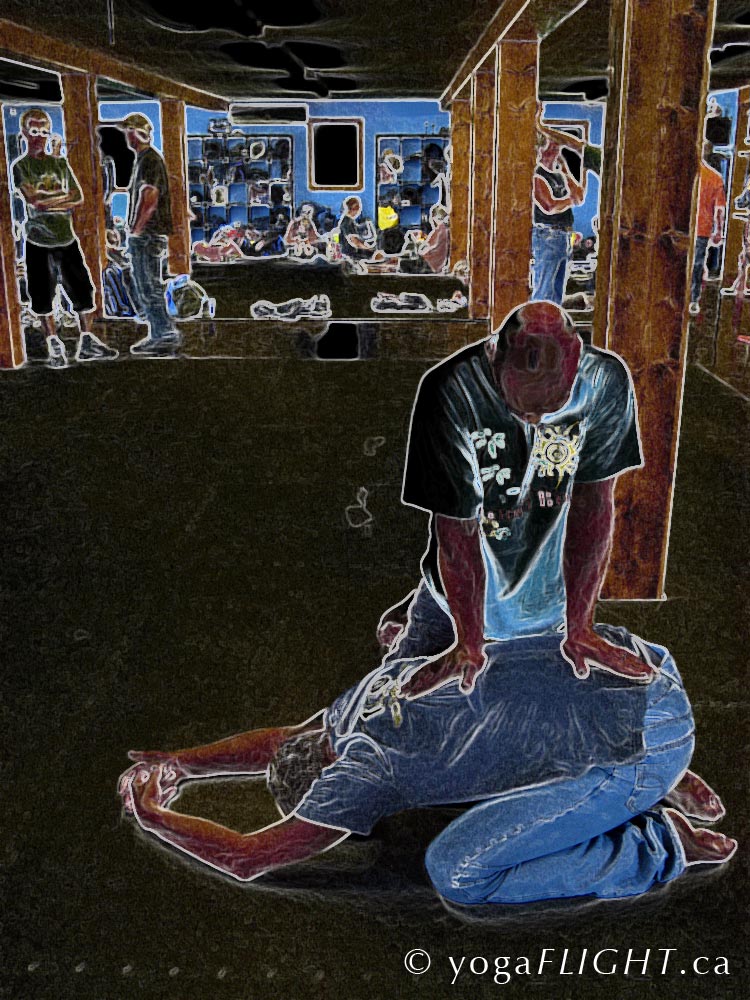Day 3 of Mission 100
 Rain day. Blah …. we were in constant limbo throughout the day as the organizers held us on standby whilst the crappy weather blew through, hopes held high that an opportune moment would have us jumping with our 40 way groups once again. Hour by hour we would meet up for an update of the situation. At one point, we were briefed for relocating our two forty ways to an alternate skydiving airfield (NovelAir) about 30 minutes away which is co-owned by this drop zone. It’s very handy indeed when the event organizers have two dropzones. Albeit kind of complicated as it involves 3 airports …. First, an air taxi from our current cloudy Parachute Montreal to the local municipal airport where the Sherpa aircraft is stationed. Then after transferring planes, we would take off and skydive in to the potentially sunny NouvelAir dropzone. The thought was extremely exciting and enticing. Having an alternative jumping plan is kind of cool and highly agreeable. Sure beats sitting around and waiting. But unfortunately, it was socked with inclement non-jumpable weather in at this airport as well. No luck for us today. The weather goDS would tease us with moments of beautiful blue clear skies and then the rapidly moving upper clouds would blanket the area with darkness and bouts of drizzle. Low altitude clouds are NOT a large formation skydivers’ friend. Not having the ability to 100% visualize the other skydivers surrounding us, especially when we’re tracking and under canopy, is asking for an accident of mammoth proportions to happen. For me, it’s totally not worth the money to have 110% controlled safety. As with any and all skydiving activities, safety is a paramount feature in big way camps and record attempts. I’m thankful for experienced captains who are being smart and cautious in their organizational efforts.
Rain day. Blah …. we were in constant limbo throughout the day as the organizers held us on standby whilst the crappy weather blew through, hopes held high that an opportune moment would have us jumping with our 40 way groups once again. Hour by hour we would meet up for an update of the situation. At one point, we were briefed for relocating our two forty ways to an alternate skydiving airfield (NovelAir) about 30 minutes away which is co-owned by this drop zone. It’s very handy indeed when the event organizers have two dropzones. Albeit kind of complicated as it involves 3 airports …. First, an air taxi from our current cloudy Parachute Montreal to the local municipal airport where the Sherpa aircraft is stationed. Then after transferring planes, we would take off and skydive in to the potentially sunny NouvelAir dropzone. The thought was extremely exciting and enticing. Having an alternative jumping plan is kind of cool and highly agreeable. Sure beats sitting around and waiting. But unfortunately, it was socked with inclement non-jumpable weather in at this airport as well. No luck for us today. The weather goDS would tease us with moments of beautiful blue clear skies and then the rapidly moving upper clouds would blanket the area with darkness and bouts of drizzle. Low altitude clouds are NOT a large formation skydivers’ friend. Not having the ability to 100% visualize the other skydivers surrounding us, especially when we’re tracking and under canopy, is asking for an accident of mammoth proportions to happen. For me, it’s totally not worth the money to have 110% controlled safety. As with any and all skydiving activities, safety is a paramount feature in big way camps and record attempts. I’m thankful for experienced captains who are being smart and cautious in their organizational efforts.
 During one of our group meetings today, we were briefed on the characteristics and inherent possibilities of hypoxia, when jumping from altitudes of 18,000 feet or higher. Hypoxia is a physiological condition experienced whereby there is a deficiency in the amount of oxygen reaching the tissues and brain. So far on our skydives since Monday, we haven’t had to use supplemental oxygen, but come Thursday when we hopefully jump form 18,000 feet or higher, it’s important that we are familiar with the equipment and use of oxygen.
During one of our group meetings today, we were briefed on the characteristics and inherent possibilities of hypoxia, when jumping from altitudes of 18,000 feet or higher. Hypoxia is a physiological condition experienced whereby there is a deficiency in the amount of oxygen reaching the tissues and brain. So far on our skydives since Monday, we haven’t had to use supplemental oxygen, but come Thursday when we hopefully jump form 18,000 feet or higher, it’s important that we are familiar with the equipment and use of oxygen.
Oddly enough, I have about 100+ jumps from 18,000 feet when I was lucky enough to have the opportunity to make regular skydives from high altitude at Skydive Monterey, California. Those were the days when I paid $18 to 18,000 feet (this included a bonus scenic flight over the Pacific Ocean and Hwy 1 each climb to altitude :)). At the time we never used oxygen, but today under these circumstances, when the potential for long jump runs as the 4 planes maneuver in to position (possibly evading weather or imperfect spots), it’s better to have oxygen available to us than to find ourselves with skydivers who might pass out or skydive unsafely because of the reduced oxygen in our systems.
At 6:30pm in full gear dirt diving our planned skydive, the organizers called the day, releasing us until tomorrow morning. Early rise, early start. Fingers crossed that we’ll make lots of skydives!

